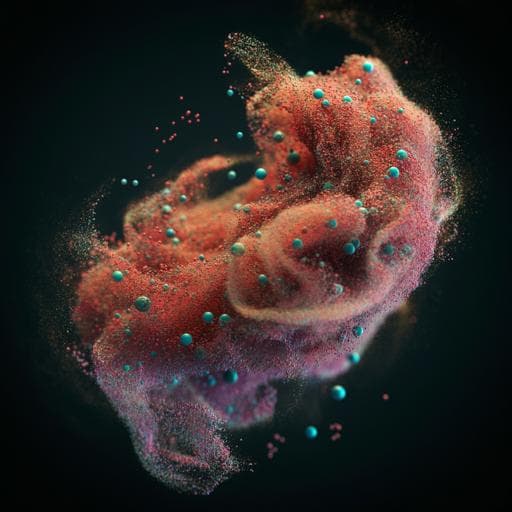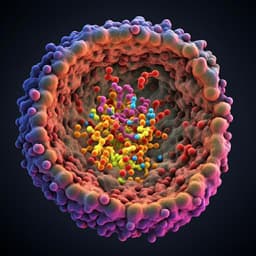
Medicine and Health
Real-time 4D tracking of airborne virus-laden droplets and aerosols
D. Pal, M. Amyot, et al.
This groundbreaking research, conducted by Devendra Pal, Marc Amyot, Chen Liang, and Parisa A. Ariya, unveils a revolutionary real-time airborne virus tracking method utilizing Nano-Digital in-line Holographic Microscopy. With an impressive resolution of 32.5 ms, this system not only detects virus-laden droplets but also enhances real-time transmission management.
~3 min • Beginner • English
Introduction
The study addresses a critical knowledge gap in in situ, real-time physicochemical characterization of airborne viruses, which is essential for accurately modeling transmission. Existing methods (e.g., PCR, immunoassays, collectors, fluorescent sensors) are not in situ nor real-time and have poor limits of detection for airborne single viruses or their clusters. Airborne transmission of SARS-CoV-2 via respiratory droplets and aerosols is widely supported, yet dynamic transformations (e.g., evaporation/condensation, coagulation, interactions with environmental constituents) remain poorly characterized in air. The authors propose Nano-DIHM, a lensless digital in-line holographic microscopy platform, as a robust imaging technology to track viruses in air and water in real time, providing 4D (3D position plus time) trajectories and physicochemical properties (size, morphology, phase, surface characteristics) without particle trapping or deposition. The study aims to validate Nano-DIHM against electron microscopy, demonstrate real-time detection and classification of MS2 bacteriophage and SARS-CoV-2 in dynamic and stationary modes, and evaluate performance in complex matrices (inorganic/organic coatings).
Literature Review
The paper reviews evidence that SARS-CoV-2 is transmitted via infectious respiratory fluids, with key pathways including inhalation of droplets/bioaerosols, deposition on mucous membranes, and fomite contact. Conventional virus detection and sampling technologies (molecular assays, immunoassays, multistage collectors, optical/fluorescent sensors, PCR variants) provide valuable information but lack in situ, real-time capability for single or clustered airborne virus detection. Bioaerosols undergo physicochemical transformations and interact with gases and particles, forming complex mixed structures whose evolution depends on environmental conditions (temperature, humidity, radiation, air dynamics) and interfaces. This transformation complicates interpretation of size, morphology, and infectivity over time. Prior aerosol instrumentation such as SMPS/OPS provides real-time size distributions but cannot track individual particles’ 3D trajectories or extract per-particle morphology/phase/surface metrics. High-resolution electron microscopy can resolve morphology but is not in situ or real time. These gaps motivate an approach that couples high-speed, in situ imaging with automated classification to capture dynamic virus behavior and transformations.
Methodology
Instrumentation and principle: Nano-Digital In-line Holographic Microscopy (Nano-DIHM) uses a 4Deep desktop holographic microscope with a 405 nm laser and pinhole illumination to record holograms on a CMOS sensor. Holograms encode interference of reference and scattered light. Numerical reconstruction uses Octopus (v2.2.2) and Stingray (v2.2.2) software (patented algorithms) to recover particle size (2D/3D), phase, shape, surface properties (roughness, edge gradient), and 4D trajectories.
Experimental setup: A quartz gas-flow cuvette (700 µL, 2 mm pathlength) is integrated into the Nano-DIHM for airborne measurements; a quartz microscope slide is used for stationary samples. Airborne streams at 1.7 L min⁻¹ pass through the imaging volume, then to SMPS (10–400 nm) and OPS (0.3–10 µm) for simultaneous size distribution measurements. Background holograms are recorded with HEPA-filtered purified air (<2 particles cm⁻³) and subtracted to remove optical/experimental artifacts. Temporal resolution is 31.25–32.5 ms (32 fps). Multiple reconstruction planes bring out-of-focus particles into focus across depth of field.
Samples: Active MS2 bacteriophage (1.0×10⁹ pfu/mL; ZeptoMetrix) used as a surrogate airborne virus; aliquots diluted 100× in Milli-Q water for aqueous mode. Heat-inactivated SARS-CoV-2 provided by McGill Medicine (92 °C, 20 min; RT-PCR and sequencing-confirmed). Mixed matrices included MS2 with TiO₂ and Fe₂O₃ (metal oxides), with organics (alpha-pinene, olive oil, honey), and mixtures of SARS-CoV-2, SARS-CoV-2 RNA, and TiO₂. No staining required for DIHM; negative staining used only for electron microscopy validation.
Aerosolization modes: (1) Dry aerosols: MS2 aerosolized with a C-flow atomizer; stream passed through diffusion dryers (RH <4%) to DIHM and to SMPS/OPS. (2) Mixed dry aerosols: MS2 + TiO₂ aerosolized and dried similarly. (3) Droplets: MS2 droplets generated by a bubbler (no dryer) or by atomizer to mimic cough/sneeze. For SARS-CoV-2, droplet flows mimicked sneeze/cough air velocities of ~10, 20, and 30 m s⁻¹.
Numerical reconstruction and trajectory analysis: Background subtraction of holograms; reconstruction at appropriate Z planes (e.g., Z ≈ 367–3267 µm for MS2 aqueous; Z ≈ 627–1570 µm for MS2 airborne; specific Z examples provided in figures). For trajectories, series of holograms are reconstructed at fixed Z (e.g., Z = 5409 µm for droplets; Z = 1790 µm for moving air) and summed to visualize 4D tracks. Intensity and phase cross-cuts quantify sizes (FWHM), phase shifts, and morphology.
Automation and AI classification: Stingray software conducts object detection, in-focus selection (Kirchhoff–Fresnel-based reconstruction), and deep neural network-based classification. Training used >10,000 holograms and >100,000 iterations. Classifiers built for multiple taxa/materials: MS2 (dry aerosol), MS2 (moist droplets), TiO₂ (dry aerosol), 200 nm PSL (dry aerosol), SARS-CoV-2 + SARS-CoV-2 RNA + TiO₂ (water), SARS-CoV-2 + MS2 (air and water). Input parameters include camera pixel size, laser wavelength, source-to-camera distance, optimized intensity threshold and edge gradient with ±5% flexibility. Automated outputs include size, shape, surface area, roughness, and edge gradient. YES/NO classification demonstrated for distinguishing SARS-CoV-2 from MS2 in mixed samples.
Validation and auxiliary analyses: Morphology and size validated with high-resolution Talos F200X G2 S/TEM and Tecnai G2F20 S/TEM. MS2 hydrodynamic size in water measured with Litesizer 500 PSA. Coupled SMPS/OPS provided real-time airborne size distributions. UV-B exposure experiments (280–315 nm, 30 min) evaluated effects on MS2 surface properties (edge gradient).
Key Findings
- Validation of MS2 detection: Nano-DIHM accurately captured MS2 sizes, shapes, phase, and surface features in stationary and dynamic media, validated by Talos-S/TEM and S/TEM. In 100× diluted aqueous samples, MS2 morphology shifted from spherical to aggregates; hydrodynamic size peaks near ~200 nm and ~700 nm (PSA) aligned with Nano-DIHM.
- Airborne MS2 size distributions and morphologies: Dry aerosol MS2 showed peaks between 60–200 nm (SMPS/OPS corroboration). Nano-DIHM observed particle sizes from tens of nm to several µm with varied morphologies (spherical to irregular), intensity/phase cross-cuts showing positive and negative phase shifts of ~2.6–4 radians, consistent with coagulation/aggregation during aerosolization.
- 3D size statistics (single-hologram, Octopus; units µm):
• MS2 dry aerosol: median width 0.18, height 0.18, length 0.38; 99th percentile length 1.74.
• MS2 + TiO₂ dry aerosol: median width 0.34, height 0.33, length 0.66; shift toward larger sizes (150–350 nm peak) consistent with attachment/aggregation; EM confirmed TiO₂ attachment.
• MS2 droplets (sneezing model): median width 0.77, height 0.73, length 1.12; larger due to moist envelopes.
- 4D trajectories: Nano-DIHM tracked dynamic 3D motion of MS2 droplets and dry aerosols at 31.25 ms resolution, revealing random motion and time-evolving aggregation/coagulation.
- SARS-CoV-2 detection in dynamic mode: Inactivated SARS-CoV-2 droplets were imaged with background subtraction and in-focus reconstruction; intensity and phase reconstructions yielded particle/cluster sizes of ~400 nm, 600 nm, 1.2 µm, and 3.4 µm; morphological evolution and random motion captured in 4D trajectories. 3D size distributions spanned ~300 nm to several µm, increasing with higher simulated sneeze velocities due to aggregation/coagulation.
• SARS-CoV-2 droplet 3D medians (µm): Q1 (10 m s⁻¹): width 0.45, height 0.41, length 0.60; Q2 (20 m s⁻¹): width 0.51, height 0.49, length 0.61; Q3 (30 m s⁻¹): width 0.56, height 0.55, length 1.58.
- SARS-CoV-2 detection in stationary mode: Intensity and phase reconstructions showed particles from ~1 µm to several µm; phase shifts ~3.1–4.1 rad (positive) suggesting water uptake; negative phase variations 3.2→2.6 rad across different particle sites.
- Automated classification: Stingray achieved ~99% accuracy in training for identifying SARS-CoV-2 vs. other targets from holograms; YES/NO classification demonstrated for mixed SARS-CoV-2 + MS2 samples. Authors note operational accuracy of >90% and potential decrease with matrix complexity.
- Surface and coating effects: Distinct edge gradient and surface roughness differences separated SARS-CoV-2 from PSLs, olive oil, MS2, and metal oxides. UV-B exposure reduced MS2 edge gradient by ~half vs. unexposed. Coatings altered MS2 morphology: TiO₂ attachment increased size to µm scale; olive oil induced contact-type adhesions; alpha-pinene suggested layered surface modification; honey led to elongated/agglomerated structures. EM confirmed TiO₂ and oil attachments.
- Practical capabilities: Real-time, in situ, label-free detection of single/ensemble particles with millisecond temporal resolution; portable setup; straightforward coupling to aerosol sizers and potential PCR/microscopy units.
Discussion
The findings directly address the absence of an in situ, real-time technique for airborne virus characterization by demonstrating that Nano-DIHM can image, reconstruct, and 4D-track virus-laden droplets/aerosols, extracting per-particle size, morphology, phase, and surface properties at millisecond resolution. Validation with electron microscopy and agreement with SMPS/OPS size distributions confirm measurement fidelity. Capturing morphological evolution and phase shifts reveals dynamic processes such as water uptake, evaporation/condensation, and aggregation, which are central to understanding viral transmission pathways and persistence in air. The system’s ability to distinguish viruses from non-viral particles and to identify specific viruses in complex matrices via AI-supported classification (YES/NO) shows promise for practical surveillance and rapid response. Observations that SARS-CoV-2 droplet sizes increase with flow velocity and that coatings with inorganic/organic materials change morphology/surface properties underscore the importance of environmental context for secondary transmission and infectivity modeling. Together, these results establish Nano-DIHM as a versatile platform for real-time airborne virus tracking and physicochemical profiling, with implications for epidemiology, risk assessment, and intervention strategies.
Conclusion
Nano-DIHM can detect, classify, and determine the physicochemical properties of SARS-CoV-2 and MS2 in air and water rapidly (results in less than a minute), in situ and in real time, with a portable configuration suitable as a virus sensor. Unlike conventional COVID-19 testing, it provides dynamic, label-free 4D tracking of single and ensemble particles and can be deployed in static or dynamic modes with claimed >90% accuracy and training accuracy ~99% for automated classification. The platform’s ability to quantify surface roughness, edge gradients, and morphological changes, and to operate in complex matrices, suggests broad applicability across virus surveillance, environmental and atmospheric chemistry, noninvasive imaging, pollutant life-cycle analysis, and potential space/climate applications. Real-time tracking can inform rapid public health responses during current and future pandemics. Future work will expand classifier libraries to additional viruses, metals, plastics, and bacteria, and integrate simultaneous multi-particle measurements.
Limitations
- Sample complexity: Automated detection/classification accuracy may decrease with complex environmental matrices; requires an extensive and continually expanded classifier library to maintain performance.
- Potential contaminants: Despite HEPA-filtered reference holograms and controls, impurities (e.g., in Milli-Q water) may contribute; classifiers were used to detect/subtract contaminants, but false positives can occur.
- Identification of unknown species: Without prior classifier information, Nano-DIHM cannot reliably identify unknown species; rapid training against targeted species and confirmatory PCR may be needed.
- Inactivation status: SARS-CoV-2 samples were heat-inactivated, which may alter surface properties compared to live virus; extrapolation to infectious behavior should be made cautiously.
- Depth-of-field and focusing: Finite depth of field necessitates multiple reconstructions for out-of-focus particles, adding computational steps and potential sensitivity to reconstruction parameters.
Related Publications
Explore these studies to deepen your understanding of the subject.







